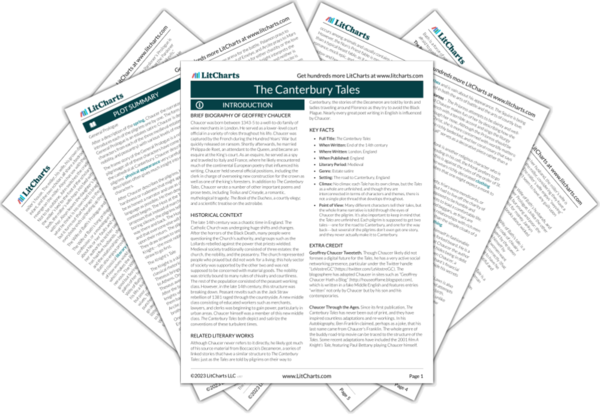Courtly love is the medieval concept of expressing admiration and love in a noble, chivalrous fashion. This type of love exists outside marriage: true courtly love exists on a spiritual, idealized plane, and does not need to be physically consummated. The Knight’s Tale centers on courtly love: the two knights compete for the hand of a fair maiden. In the General Prologue, the Host’s description of the Squire, a young knight, has all the trappings of a traditional courtly lover: he wears fancy clothes, takes care of his appearance, writes music, jousts, dances, and is so passionate in his love that he can barely sleep.
Courtly love is satirized in many of the tales that do not take place among the nobility. The Miller’s Tale turns ideals of courtly love into a rude fart joke. The Nun’s Priest’s Tale, a beast fable about a rooster and a fox, puts courtly love in the henhouse: Chaunticleer the cock is devoted to Pertelote, his favorite hen. Just like a noble knight, Chaunticleer uses classical references and is inspired by dream visions, and Chaunticleer’s crazy misreading of the message that he gets in the dream is what lets him get tricked by the fox.
In contrast to idealized courtly love, sexual desire also plays a large role in The Canterbury Tales. Many of the tales are bawdy and focus on physical lust. The Miller’s Tale, among several others, centers on sexual rivalry. The Wife of Bath is very frank about her relations with her five husbands.
The opening to the General Prologue introduces both noble love and carnal lust: men long to go on pilgrimages, Chaucer says, both when they feel religious zeal and physical desire. The birds singing and flowers blossoming are emblematic of both poetic and sexual awakening. Misplaced or disproportionate sexual desire drives many of the tales. Cuckolding is a major theme in many of the more vulgar tales. Chaucer uses lots of double entendres and thinly veiled dirty jokes to portray lust.
Sexual desire and courtly love both feature prominently in the debate over what makes a good marriage, which is a question that many of the pilgrims ask themselves throughout their tales. Both male and female roles are considered in the question of what makes successful and sustained relationships. The knight in the Wife of Bath’s Tale must answer the question, “What do women want?”
Courtly Love and Sexual Desire ThemeTracker

Courtly Love and Sexual Desire Quotes in The Canterbury Tales
Whan that Aprill with his shoures soote
The droghte of March hath perced to the roote,
And bathed every veyne in swich licour
Of which vertu engendered is the flour;
...
Thanne longen folk to goon pilgrimages
...
And specially from every shires ende
OF Engelond to Caunterbury they wende,
The hooly blissful martir for to seke,
That hem hath holpen whan that they they were seeke.
He cast his eye upon Emelya,
And therwithal he bleynte and cride, “A!”
Thus swyved was this carpenteris wyf,
For al his kepyng and his jalousye,
And Absolon hath kist hir nether ye,
And Nicholas is scalded in the towte.
This tale is doon, and God save al the rowte!
Experience, though noon auctoritee
Were in this world, is right ynough for me.
Men may devyne and glosen, up and doun,
But wel I woot, expres, without lye,
God bad us for to wexe and multiplye,
That gentil text kan I wel understonde.
By God! if women hadde written stories,
As clerkes han withinne hire oratories,
They wolde han writen of men moore wikkednesse
Than all the mark of Adam may redresse.
And whan I saugh he wolde never fyne
To reden on this cursed book al nyght,
Al sodenly thre leves have I plyght
Out of his book, right as he radde, and eke
I with my fest so took hym on the cheke
That in our fyr he fil bakward adoun.
Wommen desiren to have sovereynetee
As wel as over hir housbond as hir love
And for to been in maistrie hym above.
For gentilesse nys but renomee
Of thyne auncestres, for hire heigh bountee,
Which is a strange thing to thy persone.
Thy gentilesse cometh fro God alone.
Thanne comth our verray gentilesse of grace;
It was no thing biquethe us with our place.
And eek I praye Jhesu shorte hir lyves
That noght wol be governed by hir wyves,
And olde and angry nygardes of dispence,
God sende hem soon verray pestilence!
For al so siker as in principio
Mulier est hominis confusio,––
Madame, the sentence of this Latyn is,
“Womman is mannes joye and al his blis.”







